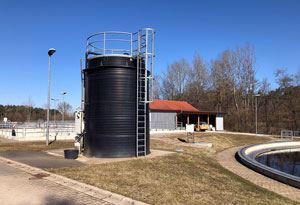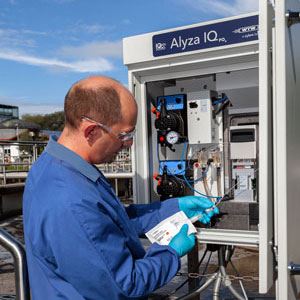7/2/2024
| Dr. Patrick Wolf
From the EU level to individual specifications for wastewater treatment plants - the discharge values for phosphorus are decreasing. The Alyza IQ PO4 provides continuous and precise values for the required phosphate precipitation.

Alyza IQ PO4
Phosphorus is an irreplaceable nutrient for plants, humans and animals. The non-renewable raw material is essential for the growth of plants and a source for fertilizer production, animal feed and industrial productions1). Its influence on the eutrophication of water bodies is visible in the strong growth of algae and aquatic plants in the event of increased input. All this and the fact that the world’s phosphorus amounts are finite1) require appropriate management in the consumption and recovery of this important substance.
Corresponding legislation is taking place at all levels of politics, from the European to the national level.
Legal situation – from Europe to national level
EU level

Regulations and requirements on phosphorus have been included in numerous EU directives. These include, for example, the Fertilizers Directive2), the Detergents Directive3) and the EU Urban Waste Water Directive4). The amendment to the latter was approved by the European Parliament on April 10, 20245). It provides for a reduction in phosphorus discharge values to 0.5 mg/L (> 150,000 PE) or 0.7 mg/L (10.000 - 150,000 PE) by 20456). This is a significant change to the previous requirements of 2 mg/L (10,000 - 100,000 PE) and 1 mg/L (> 100,000 PE), which are limited to discharges into sensitive areas4).
National states
In some member states, the European requirements have been implemented more strictly. For example, the German Wastewater Ordinance (AbwV)7) has adopted the above-mentioned values of the EU Directive as general requirements, without limiting them to sensitive areas. Other European countries have regulations that generally stipulate a limit value of 1 mg/L.
Federal states
One administrative level further down, there might be regulations in force whose requirements already go beyond what will be written in the new version of the EU Urban Waste Water Directive. In Germany, this is present for the federal states of Baden-Württemberg8), Bavaria9), Hesse10) and Rhineland-Palatinate11). The specified values are partly dependent on so-called P action areas (Bavaria) or the process technology (Baden-Württemberg, Rhineland-Palatinate) and affect wastewater treatment plants down to size 1.000 – 5.000 PE. Target values of 1 mg/L or 2 mg/L tend to be the exception; most specifications are well below 1 mg/L.
Wastewater treatment plants are often affected when a discharge permit is extended or newly issued. The permits can also be amended or adjusted by the authorities before the actual term expires. Ultimately, in all cases, these are measures to implement the EU Water Framework Directive (WFD)12), according to which all water bodies must be brought to a good ecological status by 2027.
Consequences for wastewater treatment plants

Precipitation tank with Alyza IQ PO4
These requirements result in high investment costs of several tens of thousands of euros at wastewater treatment plants. Typically, these include the construction of a tank for precipitant including safety equipment for operation and filling, the laying of pipes and pumps to the dosing point, and the associated measurement and control technology. Finally, the operating costs of several € 1,000 per year for the purchase of the precipitant must also be taken into account. This can increase by a multiple in case of supply bottlenecks (see 2022/2023).
Optimize precipitation with Alyza IQ PO4

Exchange of chemistry at the Alyza IQ PO4
Continuous monitoring of the phosphate is required in order to comply with the discharge values and keep the operating costs under control. Based on the PO4-P concentration, the amount of precipitant required can be determined in conjunction with a flow measurement. This results in the precipitant being added as required and avoids overdosing.
The measurement technology for phosphate is of great importance here. The Alyza IQ PO4 analyzer enables reliable and accurate measurement of the phosphate concentration, even at low concentrations. This is made possible by the 2-point calibration option and the compensation of yellow-colored samples. The analyzer transmits one or two measured values (2-channel device) to the PLC for control purposes via mA signals or various field buses. The consumables can be replaced by the operator, so a maintenance contract is not mandatory.
Application example
Here you will find an application report from the Hilpoltstein wastewater treatment plant on how phosphate precipitation was optimized and discharge values reduced with the Alyza IQ PO4.

Phosphate removal optimized, discharge value reduced.
Conclusion
Due to falling phosphorus discharge values and the resulting need for phosphate precipitation, the use of continuous measurement technology is becoming increasingly important. The high availability of measured values means that precipitation can be optimized – always enough, never too much. In this way, discharge values are maintained and overdosing with excessive costs is avoided.
Downloads
Our Products
Continuous Phosphate Measurement
Related products

You may also be interested in these blog posts:
References:
- What is phosphorus and why are concerns mounting about its environmental impact? – United Nations environment programme; https://www.unep.org/news-and-stories/story/what-phosphorus-and-why-are-concerns-mounting-about-its-environmental-impact; last visit on 17.06.2024
- Regulation (EU) 2019/1009 of the European Parliament and of the Council […] laying down rules on the making available on the market of EU fertilising products […] – Official Journal of the European Union; 25.06.2019; https://eur-lex.europa.eu/legal-content/EN/TXT/PDF/?uri=CELEX:32019R1009; last visit on 17.06.2024
- Regulation (EU) 259/2012 of the European Parliament and of the Council […] as regards the use of phosphates and other phosphorus compounds in […] laundry detergents and […] dishwasher detergents – Official Journal of the European Union; 14.03.2012; https://eur-lex.europa.eu/legal-content/EN/TXT/PDF/?uri=CELEX:32012R0259; last visit on 17.06.2024
- Council directive […] concerning urban waste water treatment (91/271/EWG) – Official Journal of the European Union; 21.05.1991; https://eur-lex.europa.eu/legal-content/EN/TXT/PDF/?uri=CELEX:31991L0271; last visit on 17.06.2024
- New EU rules to improve urban wastewater treatment and reuse – Press Release of the European Parliament; 10.04.2024; https://www.europarl.europa.eu/news/en/press-room/20240408IPR20307/new-eu-rules-to-improve-urban-wastewater-treatment-and-reuse#:~:text=With%20481%20votes%20in%20favour,public%20health%20and%20the%20environment.; last visit on 17.06.2024
- Urban wastewater treatment - Updating EU rules – European Parliament; © European Union 2024; https://www.europarl.europa.eu/RegData/etudes/BRIE/2023/739370/EPRS_BRI(2023)739370_EN.pdf; last visit on 17.06.2024
- German reference: Verordnung über Anforderungen an das Einleiten von Abwasser in Gewässer (Abwasserverordnung - AbwV) – Bundesministerium der Justiz; 21.03.1997; https://www.gesetze-im-internet.de/abwv/BJNR056610997.html; last visit on 25.03.2024
- German reference: Handlungskonzept Abwasser – Ministerium für Umwelt, Klima und Energiewirtschaft Baden-Württemberg; 03.03.2020; https://rp.baden-wuerttemberg.de/fileadmin/RP-Internet/Themenportal/Wasser_und_Boden/Wasserrahmenrichtlinie/_DocumentLibraries/Documents/Abwasser_allgemeine_Informationen_Vortrag.pdf; last visit on 25.03.2024
- German reference: Merkblatt Nr. 4.4/22: Anforderungen an die Einleitung von Schmutz-, Misch- und Niederschlagswasser – LfU Bayern, Referat 67; März 2023; https://www.lfu.bayern.de/publikationen/get_pdf.htm?art_nr=lfu_was_00207; last visit on 25.03.2024
- German reference: Arbeitshilfe zur Verminderung der Phosphoremissionen aus kommunalen Kläranlagen – Hessisches Ministerium für Umwelt, Klimaschutz, Landwirtschaft und Verbraucherschutz; April 2015; https://flussgebiete.hessen.de/fileadmin/dokumente/5_service/Hintergrunddokumente_2015/Arbeitshilfe_P-Elimination_UEberarbeitung_Kap_5_April_2015_2.pdf; z last visit on 25.03.2024
- German reference: Maßnahmen im kommunalen Abwasserbereich zur Umsetzung der EU-Wasserrahmenrichtlinie (WRRL; Reduzierung der Phosphoreinträge aus Kläranlagen – Ministerium für Umwelt, Energie, Ernährung und Forsten Rheinland-Pfalz; 10.01.2019; https://wasserportal.rlp-umwelt.de/fileadmin/user_upload/pdf/Pges_Optimierung_SchreibenMUEEFvom10_01_19.pdf; last visit on 25.03.2024
- Directive 2000/60/EC of the European Parliament and of the Council […] establishing a framework for Community action in the field of water policy – Official Journal of the European Union; 23.10.2000; https://eur-lex.europa.eu/legal-content/EN/TXT/PDF/?uri=CELEX:02000L0060-20141120; last visit on 17.06.2024